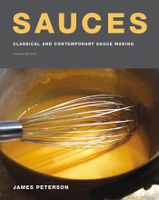Label
All
0
Clear all filters
Dos and Don’ts
Appears in
Published 1991
- Always moisten stock with cold liquid. If hot water is added to meat, it causes the meat to release soluble proteins (albumin) quickly into the surrounding liquid. These proteins immediately coagulate into very fine particles and cloud the stock. When cold liquid is used and slowly heated, the proteins contained in the meat or fish coagulate in larger clumps and float to the top, where they can be skimmed off. When adding liquid to an already simmering stock to compensate for evaporation, make sure it is cold.
- Never allow a stock to boil. As meat and bones cook, they release proteins and fats into the surrounding liquid. Stock should be heated slowly to only a simmer. At a slow simmer, these components appear as scum and grease on top of the stock and can be skimmed. If the stock is boiling, these substances are churned back into the stock and become emulsified. The resulting stock is cloudy and has a dull, muddy, greasy flavor, which will only worsen if the stock is reduced—or bound—for a sauce. When the stock comes to a simmer, keep it to one side of the heat source so any grease or scum is pushed to one side, where it can be more easily skimmed. Skim the stock with a ladle every 5 to 10 minutes for the first hour to prevent fat and scum from working their way back into the stock. As the stock cooks further, it needs to be skimmed only every 30 minutes to an hour. Keep the ladle in a container of cold water next to the pot so it is convenient for skimming and does not become caked with fat and scum.
- Do not use too much liquid. The higher the proportion of solid ingredients to liquid, the more flavorful the stock will be. Many beginning cooks cover the solid ingredients with too much liquid at the beginning of cooking. Because the solid ingredients in a stock settle during cooking, the cook often finds that he or she has added more liquid than necessary and the resulting stock is thin. It is best to use only enough liquid or stock to cover the ingredients. The only exceptions to this rule are stocks with extremely long cooking times, where any excess liquid will evaporate anyway.
- Do not move the contents of the stock during cooking and straining. As stock cooks, albumin and other solids settle along the bottom and sides of the pot. If the stock is disturbed, these solids will break up and cloud the stock. When straining the finished stock, do not press on the ingredients in the strainer; allow enough time for the liquid to drain naturally. Work slowly and deliberately.
- Do not overreduce. Stocks are often reduced to concentrate their flavor and give them an appetizing, light, syrupy texture. Although reduction is an almost essential technique for converting stocks into sauces, much of the delicacy and flavor of meats is lost if reduced for too long. Many of the flavors contained in stock are aromatic and evaporate when simmered over a prolonged period, leaving a flat taste. Highly reduced stocks often contain a large concentration of gelatin, which gives them a sticky feeling and texture in the mouth. (See “Jus”.)
- Do not add the liaison until all the fat and scum have been carefully skimmed. Recipes often suggest adding a thickener such as roux, starches such as cornstarch or arrowroot, or hydrocolloid thickeners to stock to thicken it lightly and give it texture. Once a liaison is added to a stock, any fat emulsified in the liquid will be held in solution by the liaison and will become difficult to skim off and remove.
- Store stocks carefully. Warm stock is a perfect medium for bacteria (beef broth was originally used to line petri dishes in laboratories). Avoid keeping stocks between 40° and 140°F (4° and 60°C) for long periods. The danger of spoilage increases in hot weather and when larger amounts of stock are being prepared. A quart or two (1 to 2 liters) of stock can be allowed to cool at room temperature before it is refrigerated with little danger of spoilage. Larger amounts of stock are best cooled by floating a container of ice (make sure the outside of the container is well scrubbed) in the stock to chill it before refrigerating. Large amounts of stock may require several batches of ice. If ice is limited, don’t bother using it while the stock is hotter than 140°F (60°C). Once the temperature drops into the danger zone—below 140°F—start using ice.
In this section
Part of
Advertisement
Advertisement


